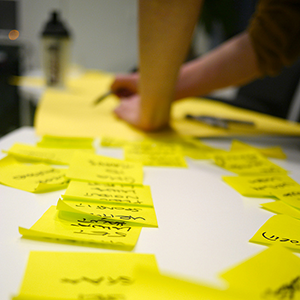In our work facilitating corporate training workshops on design thinking and executing human-centered design research and strategy projects for clients, we’ve noticed a perspective-shifting trend. Most, if not all, of our clients think they want their teams to learn design thinking to improve execution and results from problem solving. They believe that incorporating human-centered design methods and tools into their work is entirely tactical. Their goal is to build a better product or service, increase revenue, or provide their staff with valuable training.
However, no matter how pragmatic the original motivation for exploring design thinking, we quickly learn what the client (and organization) really needs and wants: a change in organizational culture.
We see this in the questions we get asked at the end of our design thinking corporate workshops. The questions start with those that are more execution-focused:
- “What do I do if a customer won’t answer my question during an interview?”
- “How do we know if our prototype is worth iterating on?”
- “How do we know which customers we should talk to first?”
- “What tools can help us do design thinking with distributed and remote teams?”
The questions quickly shift to those that are about—at their core—organizational culture:
- “How can I continue using these approaches without being ‘found out’ by my boss?”
- “How can we convince our colleagues to be open to these new approaches?”
- “How can we sustain this way of thinking into the future?”
- “I wish we could use design thinking to make our own experiences as employees better…wait…can we?”
Whether an organization is large or small, for-profit or nonprofit, design thinking both requires a culture change to be done effectively and also creates a positive culture change. Design thinking can help cultivate an organizational culture that is more innovative, collaborative, and engaging for employees.
More Than Just a Process, Design Thinking Is A Culture
Design thinking is often perceived as a set of predefined steps to be followed to solve a problem. The promise is that following the design thinking process will lead to more creative, human-centered problem solving, and more customer-centric and profitable solutions. When working with especially risk-averse clients or those learning about design thinking for the first time, framing design thinking in a process-oriented way can be useful. It demystifies it and makes it seem more accessible, repeatable, and proven. But such a reductive perception of design thinking sells it short.
For example, it would be almost impossible to recruit Average Joe off the street, hand him a carefully crafted step-by-step interview guide, and expect him to truly establish empathy with a user during a one-on-one interview. Similarly, you shouldn’t expect that simply because you prototype a concept that you are testing the right hypotheses about what will delight your user—or that you are considering your user at all (a key tenet of design thinking).
Design thinking isn’t just a process that anyone can plug and play to get a desired output. It is much more than the process it advocates or its methods and tools. Design thinking is a way of working and behaving. It is a mindset. It is a set of values. It requires intangibles—like humility and integrity—to do it right.
So, if design thinking isn’t just a “process” then what is it?
Design thinking is, in fact, a form of organizational culture, in that it represents a set of behaviors, values, and rituals that define how members of an organization do things.
In order to unlock an organization’s full potential, design must be incorporated into its core philosophy and culture. When it is, it leads to more delighted customers, engaged employees, and improved profits. Case in point: Intuit generated $10 million in additional revenue in the first year it empowered its teams through design thinking.
Leaving Organizational Culture to Chance Is Risky Business
 Just as design thinking requires integrity and good intentions, a strong company culture isn’t created by merely wishing it so. Research by Deloitte reveals that 94% of executives and 88% of employees believe that a distinct workplace culture is critical to business success. Additionally, 83% of executives and 84% of employees rank engaged and motivated employees as the top factor that substantially contributes to a company’s success.
Just as design thinking requires integrity and good intentions, a strong company culture isn’t created by merely wishing it so. Research by Deloitte reveals that 94% of executives and 88% of employees believe that a distinct workplace culture is critical to business success. Additionally, 83% of executives and 84% of employees rank engaged and motivated employees as the top factor that substantially contributes to a company’s success.
An organizational culture that is intentionally cultivated touches every facet of a company: from employee recruitment, engagement, and retention, to the development of product and service solutions, to the bottom line. Organizations that don’t pay attention to their organizational culture will see their ability to innovate and deliver results significantly diminish.
“Your culture is the behaviors you reward and punish.” – Charles O’Reilly, Stanford Graduate School of Business
The Design Management Institute has found that “design-led” companies outperform other companies by 228% on the Standard and Poor’s 500. Using design thinking as a way of working—and of thinking about working—can be effective in purposefully creating a positive organizational culture, one where creativity and innovation flourish, morale and collaboration are high, and, as a result, business performance is strong.
3 Ways Design Thinking Will Level Up Your Organizational Culture
As we’ve outlined above, design thinking is not only a valuable method to solve business problems and create bottom line value—it can also be a tool to improve organizational culture. The end result? Happier and higher-performing employees, an abundance of innovative ideas, and decreased risk.
1: Design Thinking Creates a Culture of Collaboration
 Modern work environments are not built to organically cultivate collaboration. They maintain roots in old systems of assembly-line centered factories and labor-based production. Such archaic frameworks are in contrast to the demands of the modern workplace, which require teamwork, creativity, flexibility, and critical thinking skills.
Modern work environments are not built to organically cultivate collaboration. They maintain roots in old systems of assembly-line centered factories and labor-based production. Such archaic frameworks are in contrast to the demands of the modern workplace, which require teamwork, creativity, flexibility, and critical thinking skills.
Shifting to a mindset that allows for these qualities can be challenging for many employees as it requires moving away from a mindset of competition to one of collaboration. It also demands a shift in focus from extracting value from predictable, existing processes to thinking about how to create new value.
The process of design thinking encourages – even requires – open collaboration. This, in turn, plants the seeds for an organizational culture shift toward one that values and encourages collaboration.
Three (of many) ways that employing design thinking promotes a culture of collaboration are:
- Cross-functional teams: Design thinking brings people from varied backgrounds (designers, engineers, human resources, finance, marketing, etc…) to solve problems. It requires breaking down silos and gathering a range of perspectives to find often elegant solutions to complex challenges.
- Environments and tools: Design thinking encourages securing time for teams to work together in-person, such as when a team is synthesizing qualitative research data or during ideation sessions. Using a design thinking process also guarantees that you will use inherently collaborative tools and spaces (whiteboards, Post-Its, etc…). There is very little work done in “loner” programs like Excel that may be more familiar to more traditional, less collaborative work approaches.
- An egalitarian mindset: In design thinking, all voices matter regardless of job title, level, or expertise. It’s about leading with data, information, and customer needs rather than hierarchy and ego. Design thinking requires working with humility so you can be open to having your assumptions tested.
By bringing together people with differing knowledge and skill sets, establishing collaborative environments, and encouraging ideas from everyone, collaboration begins to flow, first as a process and then as part of an ingrained organizational culture.
2: Design Thinking Cultivates Ideation
The same archaic, hierarchical factory-floor work mentality that prevents collaboration can also suppress ideation. It can divide up the workday into lists of tasks bound by strict requirements, leaving no opportunity for employees to contribute their own ideas.
Divergent thinking is one of the core tenets of design thinking and is used to generate creative ideas by exploring many possible solutions. By carving out space for brainstorming and creative thought, and by using rituals that support expansive thinking, design thinking frees organizations from the usual bureaucratic and political constraints.
Design thinking supports and promotes ideation by:
- Embracing risk and seeing failure as a positive step—even a requirement—in learning and developing the right solution. This encourages individuals and teams to go beyond their comfort zones and not play it safe. (See No. 3 below for additional details.)
- Cultivating curiosity through abductive reasoning. A logical inference, abductive reasoning seeks to find the simplest explanation for what the viewer sees. Contrary to deductive reasoning, it does not guarantee a conclusion. Design thinking requires you to ask questions from a position of humility and curiosity and to be open to any and all answers—and therefore ideas.
- Encouraging the use of creative methods from other disciplines, like improv, to boost divergent thinking.

When a company embraces a culture of ideation, tackling even the toughest challenges can be enjoyable. Problems that were once seen as barriers to success become opportunities for teams to collaborate and be creative. Prioritizing time for teams to perform real, uninterrupted thinking to solve challenges is rare. Doing so can give an organization a competitive cultural edge.
3: Design Thinking Encourages (and Requires) Productive Failure
Outdated workplaces and systems don’t have the policies, behaviors, and structures in place needed to accommodate failure, let alone encourage it. They are more focused on efficiencies, established processes, and driven by a culture of competition, which equates workplace failure to personal failure.
Failure does not have to be the end of the road. It can be a valuable learning tool that allows a company to pivot and iterate on its way to success. Design thinking recognizes failure as a necessary step in the pursuit of learning and mitigating risk.
 For example, by creating and testing imperfect, lower-cost prototype versions of multiple concepts with users, a design-led company reduces the risk associated with bringing something new to the market. IBM has implemented this tactic of constant prototyping as part of a system they refer to as “The Loop,” that has come to define their design-driven philosophy.
For example, by creating and testing imperfect, lower-cost prototype versions of multiple concepts with users, a design-led company reduces the risk associated with bringing something new to the market. IBM has implemented this tactic of constant prototyping as part of a system they refer to as “The Loop,” that has come to define their design-driven philosophy.
By reframing failures as opportunities—even requirements—for learning and iterative improvement, a company cultivates an organizational culture that allows employees to take the risks necessary for innovation without fear of making a career-ending mistake.
Design Thinking: Process and Culture (For the Price of One)
An open-minded culture built on design thinking principles celebrates exploration and experimentation. With a renewed sense of curiosity, employees are free to think big, tap into their enthusiasm, and leverage their strengths.
A company that incorporates design thinking as a process and an organizational culture is setting itself up for innovation, happy employees, and a healthier bottom line. In short, it’s setting itself up for longevity and success.

